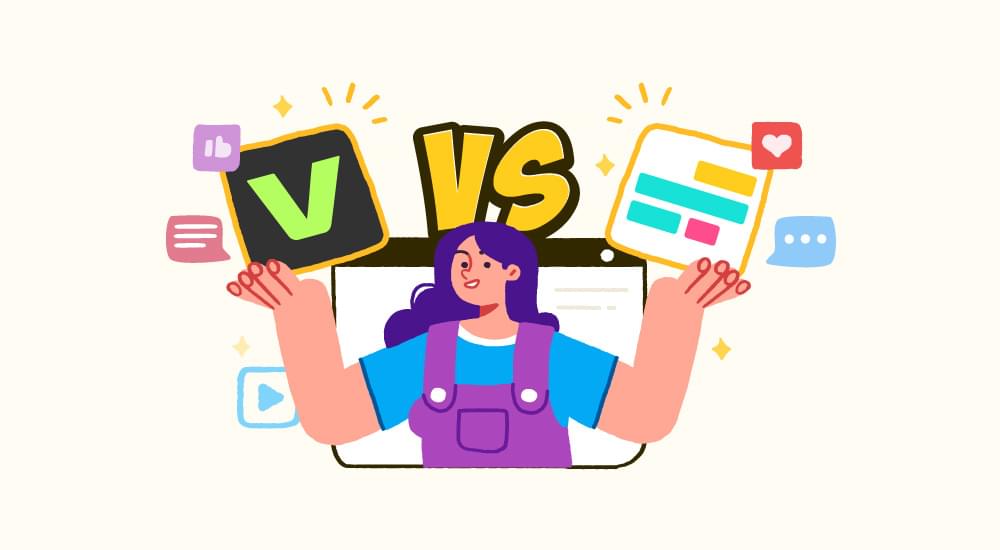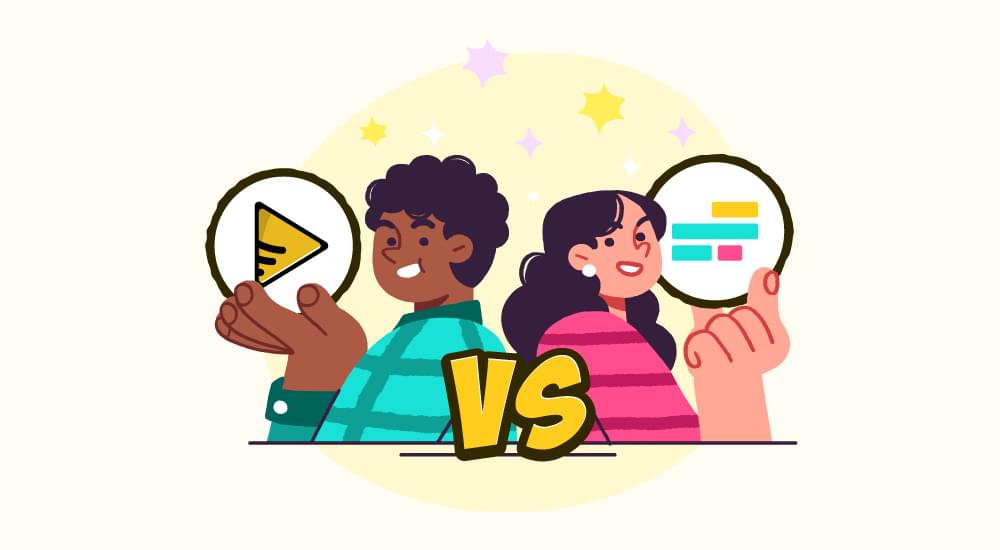
benefits of subtitles in video
What Are Forced Subtitles? A Comprehensive Guide
An important part of the world of multimedia and entertainment is subtitles. They help everyone consume the content and appreciate it while enjoying watching. However, out of all the different types of subtitles, forced subtitles are a powerhouse for some use cases. Forced subtitles or Forced Narrative (FN) subtitles are an explanation tool for specific scenarios while video making. From clarifying foreign dialogue to highlighting critical information, forced subtitles serve unique purposes that other subtitle types often cannot fulfill.
This post will be different in its approach as it explains what are forced narrative (fn) subtitles, their importance, how they differ from other subtitles.
Table of Contents
- What Are Forced Subtitles?
- What Are Forced Narrative Subtitles Used For?
- How to Create Forced Subtitles?
- When Are Forced Narrative Subtitles Used?
- Difference Between Forced Subtitles and Full Subtitles
- SDH vs Forced Subtitles
- What Are English Forced Subtitles?
- Conclusion
- FAQs
Generally speaking, subtitles are used to create a text version of audio content or sounds in a video. They can be a lifeline for viewers who are hard of hearing, watching in noisy environments, or trying to understand content in a different language. However, forced subtitles cater to more specific needs.
The forced narrative subtitles aren’t like full subtitles or SDH (subtitles for the deaf and hard of hearing), which are present throughout a motion picture. For instance, they are used to translate foreign language dialogue or display essential contextual information in a scene.
What are forced subtitles?
Forced subtitles are text displays of unspoken information that is critical to the viewer. They are used to explain conversations, burned-in text images, and other information that is not explained in the video. Forced narrative subtitles only appear when necessary.
They are used in multilingual videos where certain lines, dialogues, images, etc, are in a language that is different from the primary language of the content.
These are also called forced narrative subtitles as they are “forced” onto the screen, meaning they cannot be turned off by the viewer. It also means that forced subtitles cannot be downloaded. Hopefully, it explains what is forced narrative subtitle is.
Forced subtitles are automatically displayed and do not require any manual activation.
Precise forced subtitles help filmmakers and content creators provide uninterrupted narrative flow to every sort of audience. Whether you’re a viewer or a content creator, understanding what forced subtitles are helps you create a comprehensive and captivating way of storytelling.
What and how are forced narrative subtitles used?
Forced narrative subtitles are used to convey information to the viewer in any of the below-mentioned five scenarios. Let’s understand what they are and why forced subtitles are useful.
Translating periodic foreign languages
Although a movie may be done in one source language, there are times when some characters will speak a short segment or phrase in a different language. Suppose during this scene, some information is relevant to the main idea of the movie or a series, FN subtitles will be involved so that the audience understands the said scenario better.
One of the most iconic uses of forced subtitles happened in the movie “Inglourious Basterds”. The movie features characters that speak multiple languages like English, German, French, and Italian. The conversation switches between these languages, and forced subtitles provide the translations to the audience.
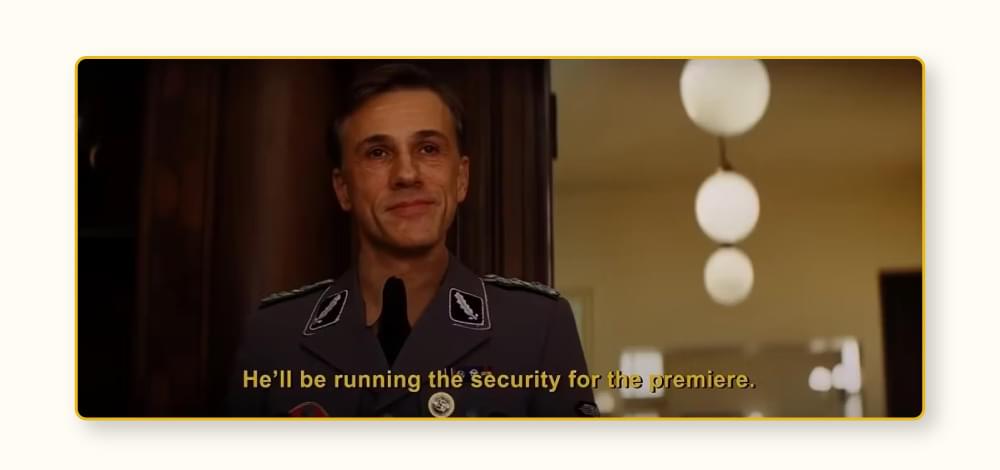
Decoding sign language, cryptic or ancient scripts in movies
Remember, in the movie Avatar, when Jake Sully first meets with Neytiri’s tribe, many dialogues are spoken in the Na’vi language. A notable line is spoken during their introduction.
“Fìswiräti fahew akewong”
Now, I didn’t know what her father said until its forced subtitles appeared on my screen.
“His alien smell fills my nose.” 😀

This use of forced subtitles dips the audience in Pandora’s culture while ensuring viewers follow the story.
Similarly, when sign language (sign language for deaf people or any other reason sign language) is used or when someone reads from an old scroll or speaks an ancient language in the movie, forced subtitles appear to help us understand the scene.
Displaying text on objects like signs, letters, or maps
Sometimes, burned-in textual graphics are used to enhance the viewing experience. Oftentimes, these are labels for locations, names, or dates. Since they are burned into the video in the original language, FN subtitles are used to translate them for viewers.

Transcribing dialogues
Remember when there are scenes with a lot of noise in the background or a lot happening at once in the scene while characters are speaking to each other? The dialogues are transcribed and displayed as forced subtitles to ensure that viewers grasp the narrative fully, even when the dialogues aren’t spoken aloud.
Providing unspoken information
Sometimes, forced narrative subtitles are used to explain the scene in which nothing is being said or done, but the information in forced subtitles is crucial for the sequel scenes. For example, the year or location name etc.

We can certainly say that forced narrative subtitles maintain the high experience of the content by bridging the possible language gaps. And since forced subtitles are always important for understanding the plot, they are a made to must-appear-on-screen.
How to create forced subtitles?
Creating forced subtitles involves several steps, including the fact that you understand that they are translations for foreign language dialogue, signs, or when minimal dialogue is spoken. Let’s follow the steps to create them.
1. Choose software
Choose a subtitle editing software of your choice. Names of some suggested software are:
- Aegisub (Free and advanced)
- Subtitle Edit (Free)
- Video Editing Software (e.g., Final Cut Pro, Adobe Premiere Pro)
2. Create forced subtitles
- Download and install the software from its official site.
- Import your video into it.
- Add Subtitles
- Pause the video at the scene where you want to add the forced subtitles.
- Type the subtitle text (e.g., translation or description).
- Adjust the start and end time of the display.
- Adjust font, size, position, and color to your choice.
- Save the subtitle file in a subtitle-compatible format (e.g., .ass, .srt).
3. Embed subtitles into the video
Some software like HandBrake lets you embed the subtitles in the subtitle file permanently. To do so:
- Import the video and subtitle file, and select “Burn In” to make subtitles permanent.
- Start encoding to create a video with embedded forced subtitles.
4. Test and adjust
Play the video to check subtitle timing, readability, and synchronization.
5. Export video
Export the final video or subtitle file with forced subtitles embedded.
When are forced narrative subtitles used?
You must have come across many examples of Forced narrative subtitles already if you watch visual content regardless of the platform. Oftentimes, movies show situations where the audience might miss important incidents if FN subtitles are not created. Let’s discuss the most common circumstances:
Foreign language dialogues
When characters switch to a different language mid-dialogue, forced subtitles are used to describe what the characters are saying.
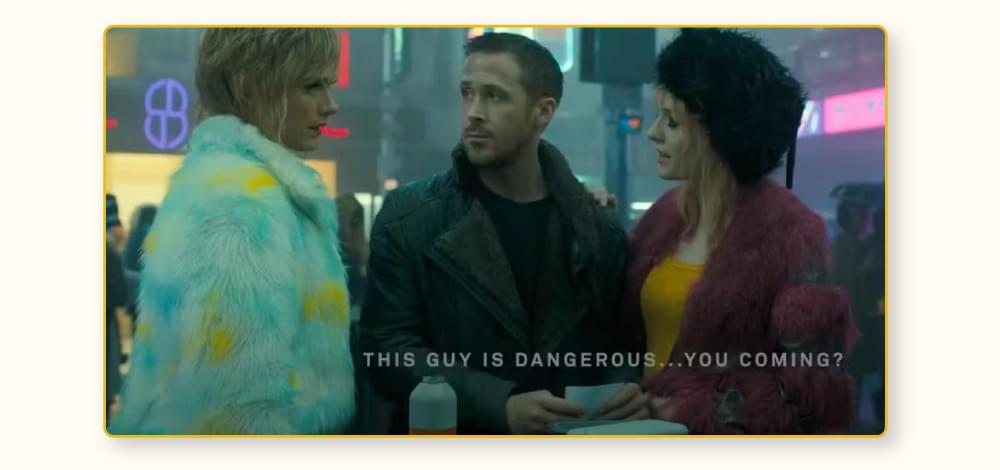
Contextual clarifications
Forced subtitles help when movies or shows display text in a foreign or symbolic script. For instance, translating an important road sign or a warning into another language is to be given in the video.
Fantasy or Sci-Fi settings
Films in genres like fantasy often feature fictional languages or symbols. This requires forced subtitles to clarify their meaning.
Dubbing support
In dubbed films, forced subtitles are used to provide translations or additional context for scenes that would otherwise lose meaning. For example, signs, numbers, city names, etc.
What is the difference between forced subtitles and full subtitles?
When forced narrative subtitles are displayed on the screen, they appear similar to the typical subtitles or closed captions. However, their display might vary depending on the platform, player, television, or other viewing device in use, just like with closed captions and subtitles.
Understanding the difference between forced subtitles and full subtitles is necessary, especially if you are a video editor. Below, we explain the main differences.
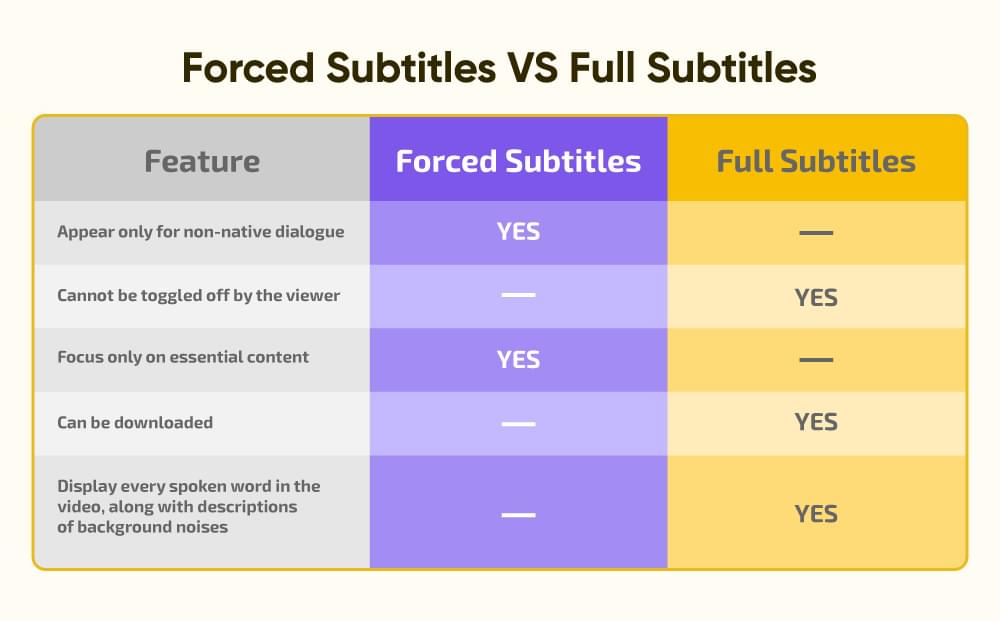
I hope you understand now that there is no complaining “forced subtitles are not working” because they are embedded in the video, cannot be downloaded, and they always work.
SDH vs forced subtitles
SDH subtitles (Subtitles for the Deaf and Hard of Hearing) include descriptions of sound effects, speaker identification, and every spoken dialogue. However, Forced subtitles only display selective content that increases understanding of the scene, regardless of the hearing abilities of the viewer. Forced subtitles, however, would translate or clarify only critical parts of a scene.
What does an English forced subtitle mean?
English forced subtitles mean that subtitles will automatically appear on screen in the English language if the viewer has the audio or subtitles set to any other language. They are subtitles used to ensure non-English dialogue or important text is subtitled to English-speaking viewers.
Let’s say for example, this scene in the movie “The Mummy”; here English forced subtitles appear and translate the conversation.

Conclusion
The basic knowledge of English forced subtitles, forced narrative subtitles, and their differences from SDH helps viewers and creators appreciate the content even more. Whether translating foreign language dialogue or clarifying important text, FN ensures that no details are missed.
I hope from now on, you will understand what FN subtitles are and how they might have been created.
FAQs
What does a forced subtitle look like?
Forced subtitles only appear when needed in any scene. Let’s say you are watching the movie without activating the subtitles, but some text appears on the screen every time, this is a Forced Subtitle.
How do forced subtitles affect the viewing experience?
Forced subtitles enable the viewers to understand critical moments without flooding them with unnecessary text. This definitely enhances the viewer’s experience, especially when they are watching the movie without subtitles.
Are forced subtitles available in all languages?
Forced subtitles can be created in any language, provided the source material supports it. However, their availability depends on the media producers and distributors.
What does it mean when subtitles are forced?
Forced subtitles clarify only the necessary information that would not be understood by the audience. The subtitles are “forced” because a viewer will not have to toggle the subtitles on to see them.
Related Reads:
What are SDH subtitles
Best Halloween Movies
Maximize SEO of your YouTube Video
Best times to post on TikTok 2024
How caption generators are transforming podcasting
Add and translate your subtitles to more than 100 languages with high accuracy








